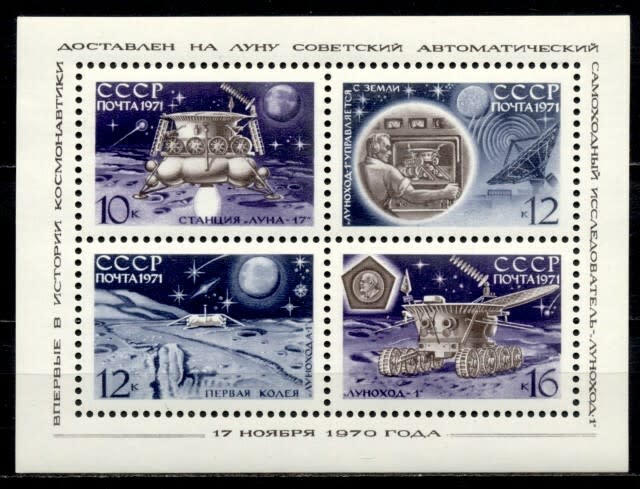In the Proptech world, we prefer the term “engineer” over “developer”. Initially, we had made this adjustment to avoid confusion with property developers and to build a context bridge for property people who are dealing with the construction and civil engineers every day.
For me personally, the engineer has an additional meaning, deeply ingrained from an early childhood spent in the USSR. My parents were engineers spearheading the country’s transformation towards the clean energy generation, and my grandfather worked on the majority of the Soviet space missions from launching the first human into space to designing humanity’s first space rovers that flew to the Moon the first Venus probe and later on building the first long term human habitat in LEO.
Soviet post stamp depicting the achievements of the robotic lunar exploration
Engineering is all about finding solutions in a very constrained and volatile environment, under time and capacity pressure.
We often take less travelled paths and go where nobody else has ever been. As software engineers, we need to make sure the solutions we bring and implement align with overall business goals.
Today, you can not afford to have engineers in your team who do not understand your business well
It’s too easy to fall into a trap of developing technology for technology’s sake, increasing the complexity of the systems you operate without any real increase in the value you generate for your customers as a business.
A couple of decades ago, a software developer could afford to learn just one technology stack and stay within that stack for the rest of their lavish career. They would be given very detailed technical-level instructions on what to implement and how, the majority of the decisions would have already been made for them.
Remember, they used to call themselves with these niche and now-obsolete terms like ‘Backend engineer’ or ‘iOS developer’? These days have long gone, my friends.
In the 2020s engineering teams around the world are responsible for the decisions that will shape future products billions of people will depend on. The work of software engineers should be aligned as closely as possible with the value our companies create.
Knowing one tool is no longer enough, we need to master a multitude of tools to pick the right one for a particular solution. And that goes beyond mastering multiple languages and frameworks: we need to become creative, finding solutions outside of our direct area of expertise.
Not every problem needs to be solved with code
Quite often the best solution would be in writing no code at all, but those solutions will only be visible for the engineers who understand the business, and we need to evolve or risk becoming deprecated.
What radical change can you bring to your company today to ensure you are delivering value?
If you are a business owner, you should find a way to invest in bridging the gap between the business and technology, that investment will future-proof your organisation, allowing it to thrive in the constantly changing world we live in.
As an engineer, you should spend more time understanding what your business does, what is the value that you create for your customers.
You should learn new technologies that would allow you to radically reduce the complexity of your solutions. One should always challenge the status quo.
Here is a couple of questions you can ask yourself today:
- If your users are only interacting with the UI, can you re-architect your technology stack in a way that would allow you to focus 90% of the effort on the UI and UX? And specifically, you should focus on what makes up your unique value proposition.
Users don’t care about how RESTful your API is or what database you are using, they care about UX though. A lot.
- What value does reinventing the wheel all over again bring to your customers? There are so many great building blocks out there so it’s much better to save your team some time by just adopting those and reinvesting this time to that one unique thing that makes your product great for the users.
There is no silver bullet
You will need to come up with your own creative solutions. But if you are looking for the place to start, at Skychute we found that by adopting technologies such as GraphQL-powered backend as a service (Hasura), we could spend 90% less time on the backend boilerplate and instead focus this energy back on making the great UX, putting our effort where our money comes from, launching products that users love.
Here to help
Whether you are an engineer looking for advice on how to increase the value you create for your company, or a manager looking to bridge the gap between the business and technology, I’m always happy to chat.








Top comments (0)